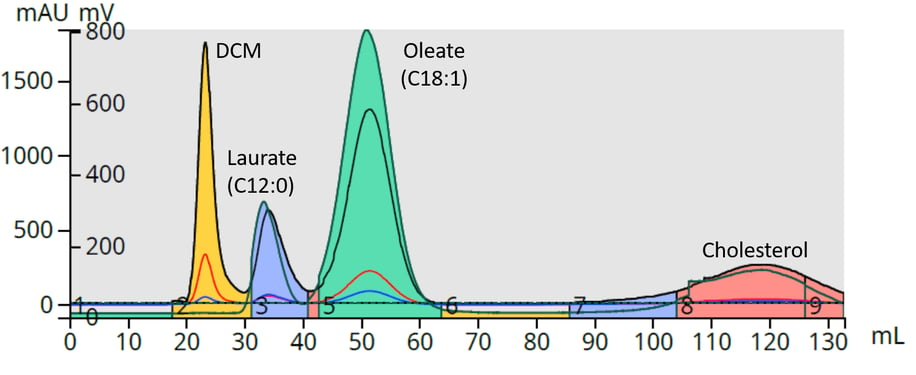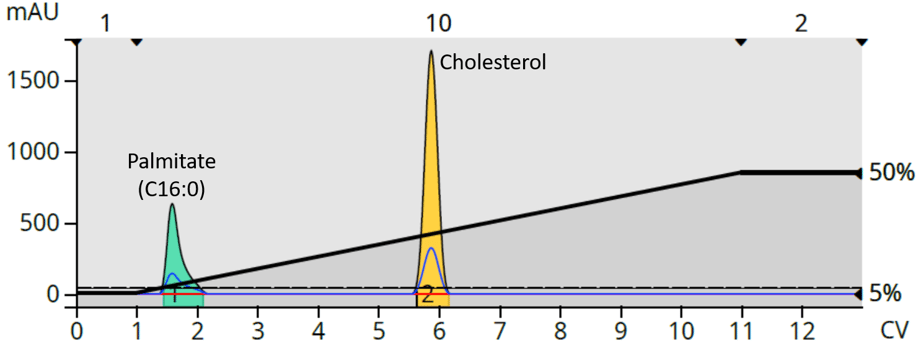COVID-19 caused accelerated research into developing vaccine options. Some of the created vaccines are based on mRNA which, if not protected, easily degrades in humans before its therapeutic benefits can be realized.
To protect the mRNA and enable its effectiveness, pharmaceutical companies have worked with biotechnology companies to create more viable cell delivery options. The most widely used is lipid nanoparticle (LNP) encapsulation. This technology uses microfluidics to combine the vaccine, lipids, other excipients, and adjuvants into small spherical particles called LNPs.
The lipid mixtures used typically contain one that is cationic, one that is PEG-based, a phospholipid, and one that is neutral, such as cholesterol. Due to the nature of these molecules, many purification techniques such as distillation or crystallization are either extremely difficult or impractical to use so the industry has faced a new challenge at scale. Luckily, lipid molecules tend to be well suited to off-the-shelf purification methods and platforms, such as Biotage automated flash chromatography development systems (Biotage® Selekt) and scale up (Biotage® Flash 400) platforms for rapid scale up – by both normal-phase and reversed-phase methods.
Historically, detection by UV was hindered since these compounds have little UV absorbance. This problem required alternative detection techniques (evaporative light-scattering, (ELS)), or just collection by volume with post-purification analysis by TLC with staining or charring. Modern flash chromatography systems now utilize photo-diode array UV detection, which can be focused in the absorption range for the targeted molecules thus enhancing their detectability.
Reversed-phase flash chromatography separates compounds based on their hydrophobicity differences through a partitioning mechanism as seen with the lipid chromatogram below where compound retention increases with the number of carbons in the molecule, Figure 1.

Figure 1. Reversed-phase flash chromatography purification of methyl laurate, methyl oleate, and cholesterol in 100% methanol with UV (198-210 nm) and ELS detection. All lipids are easily detected by both UV and ELSD including the fully saturated methyl laurate.
Normal-phase chromatography, on the other hand, separates compounds based on polarity differences using an adsorption-desorption mechanism. Lipophilic compounds elute quickly and those that are more polar elute later. For lipid purification, this can be beneficial as fatty acid type compounds will only be marginally retained, while cholesterol and other more polar compounds will be retained better, Figure 2.

Figure 2. Normal-phase flash chromatographic purification of methyl palmitate and cholesterol. The fully saturated palmitate is too lipophilic to be retained while cholesterol, with a hydroxyl group, is well retained.
These examples were performed a low scale (<100 mg) using small flash columns (10 gram) but the purification methods are easily scaled to 100’s of grams to even kilogram-scale by using larger columns from Biotage up to 50 kg (Biotage® Flash 400L).
So, if you are involved in the world of lipid production and need to purify your lipids, consider your options. Depending on your goals, it is very likely either normal-phase or reversed-phase flash chromatography will help you attain them.
Interested in learning more about fast-tracking purification? Follow the link below:

 Organic Workflow
Organic Workflow Peptide Workflow
Peptide Workflow Scale-Up Flash Purification
Scale-Up Flash Purification  Sample Preparation
Sample Preparation Biomolecule Purification
Biomolecule Purification Oligo synthesis
Oligo synthesis Scavengers and Reagents
Scavengers and Reagents Service & Support
Service & Support Accessories & Spare parts
Accessories & Spare parts Investors
Investors Reports & News
Reports & News The Share
The Share Corporate Governance
Corporate Governance Calendar
Calendar Sustainability
Sustainability Our Offering
Our Offering Our History
Our History Our Locations
Our Locations Leadership
Leadership